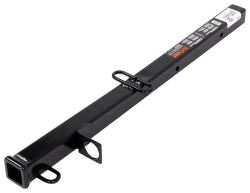
Hitch Extension Needed To Flat Tow
Question:
Someone on one of the iRV2 forums recommended you folks to help me with the following towing issue. I need help me finding a safe hitch extension solution that will take into account a motor cycle lift Cruiser Lift attached to the back of our motor coach and safely tow a vehicle weighing 6,600 pounds. The towing vehicle is a diesel pusher motor coach. As mentioned there is motor Cruiser Lift on the back of the coach, which requires an extension bar so that we can tow our truck. The Cruiser Lift hitch specifications include: Receiver Size: 2½” Type: Class IV Receiver Max Torque Weight: 1,000 lbs Max Gross Trailer Weight: 10,000 lbs The vehicle being towed pulls straight from the cruiser lift receiver hitch, not from the motorcycle tray frame. The tow bar that connects to the towed vehicle is manufactured by Blue Ox, model BX7445/BX7450 Aventa LX Tow Bar, which is a Class IV tow bar, steel construction and with a 10,000 lb rating. The Blue OX hitch bar extends about 7” from the back of the receiver to the tow bar arms. The Cruiser Lift originally came with a standard 32” class IV tow bar extension, but the maximum tow capacity of this extension is only 6,000 pound flat tow capacity. This was OK when we were towing a Jeep Wrangler. However, we have replaced the Wrangler with a 1500 truck that weighs approximately 6,500 pounds when it is fully loaded and ready to be towed. What we need is an extension that will allow us to safely tow the 6,500 pound truck. In addition to safely towing 6,500 pounds the extension needs to be long enough so that we can make sharp right or left hand turns if we need to and the truck will not bump into the truck. A word about the frame that holds the motor cycle and which attaches to the lift. 1. The frame is about 26” deep and extends about 3” beyond the end of the 32” extension bar that came with the lift. • The frame is about 68” across. In my opinion, I think the ideal length of the extension would be about 36”. This would provide ample distance from the lift and should allow enough room to make sharp right or left hand turns. My research so far as focused on an extension bar, but I understand there are also extension tubes. Is there a difference between what an extension bar can safely tow and what an extension tube can safely tow? What is the maximum length of an extension bar that will safely tow 6,500 pounds? What is the maximum length of an extension tube that will safely tow 6,500 pounds? When I look at Receiver Tubes on line, most only come with one hole at the receiver end. But, what If I drilled a hole at the other end of the tube so that I could secure that end to the receiver hitch would that work? At the risk of asking a really dumb question, does the thickness of the receiver tube wall make a difference? I would assume that it does. So, if a tube is potentially a better alternative than a bar, what would be the ideal combination of length and wall thickness that would allow me to safely tow 6,500 pounds? And, finally, what do you sell to meet this? Thanks for your help.
asked by: Bruce O
Helpful Expert Reply:
The difference between a tube extension and a hitch extension is splitting hairs on terms. The difference between a combo bar that you could drill a hole in and an extension is the finish. The extensions have a powder coated finish and the combo bars are raw so they can be welded for custom applications. They will have the same weight ratings as their counterparts. The thickness of these bars are the same.
I've attached a link to the available extensions for you to consider as well as custom fabrication parts. You may need something customized, so let me know if you need further help.

Product Page this Question was Asked From
Curt Hitch Extension and Reducer for 2-1/2" Trailer Hitches - 24" to 34" Long
- Hitch Adapters
- Hitch Extender
- Hitch Reducer
- Bike Racks
- Cargo Carriers
- Hitch Mounted Accessories
- Trailers
- 24 - 34 Inch Extension
- Fits 2-1/2 Inch Hitch
- 2-1/2 Inch to 2 Inch
- 6000 lbs
- CURT
more information >
Featured Help Information
Instructions
Miscellaneous Media

Continue Researching
- Shop: Curt Hitch Extension and Reducer for 2-1/2" Trailer Hitches - 24" to 34" Long
- Shop: Trailer Hitch
- Q&A: Recommended Equipment for Flat Towing 2013 Ford C-Max Behind Motorhome
- Shop: Vehicle Tow Bar Wiring
- Shop: Curt Cam Buckle Stabilizing Strap for Hitch-Mounted Accessories - 61" x 1" - Qty 1
- Shop: Vehicle Tow Bar Brake System
- Shop: Base Plate for Tow Bar
- Shop: Blue Ox Acclaim Non-Binding Tow Bar - Coupler Style for 2" Ball - Car Mount - 5,000 lbs
- Shop: Demco Air Force One Flat Tow Brake System for RVs w/ Air Brakes - Wireless Monitoring - Proportional
- Search Results: hitch extension 2.5
- Shop: Curt Trailer Hitch Receiver - Custom Fit - Class II - 1-1/4"
- Shop: TorkLift Cannon Hitch Extension - 3" Ford Super Duty Factory Hitch - 36" Long
- Shop: TorkLift SuperTruss Hitch Extension for SuperHitch Trailer Hitch Receivers - 48" Long
- Video: Curt Hitch Adapters - Hitch Extender - C45048 Review
- Search Results: 18050
- Search Results: super hitch
- Video: Review of TorkLift Hitch Adapters - Ford Super Duty Hitch Extender - TLE1636
- Shop: Trailer Wiring
- Shop: Roof Rack
- Video: Roadmaster Diode 7 to 6 Wire Coil Kit Installation - 2015 Ford C-Max
- Video: TorkLift Hitch Adapters - Hitch Extender - TLE1536 Review
- Shop: Vehicle Sway Bars
- Search Results: turn buckle
- Article: How Much Solar Power Do I Need For My RV?
- Q&A: Replacing 6-Way on Trailer With 7-Way Connector
- Article: How Level Should a Tow Bar Be When Flat Towing
- Article: Wiring Trailer Lights with a 6-Way Plug (It's Easier Than You Think)
- Video: Blue Ox Base Plate Installation - 2017 Ford C-Max
- Search Results: safety chains
- Q&A: Can Curt Hitch Extender part # C45048 Fit Into Factory Hitch of 2003 Dodge Ram 2500





